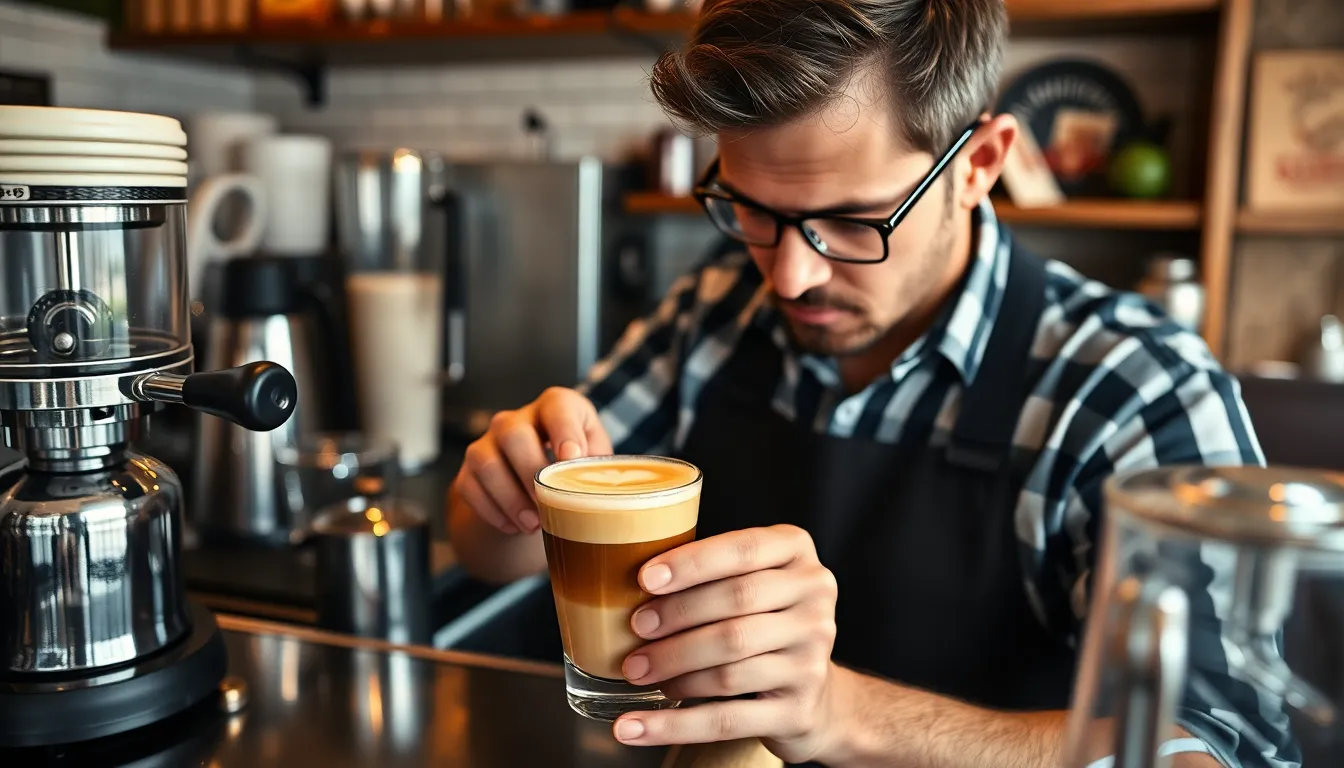When it comes to coffee, choosing between a macchiato and a latte can feel like picking a favorite child—impossible and fraught with guilt. Both drinks have their loyal fans, but understanding the difference can elevate your coffee game from amateur to barista-level. Imagine strutting into your local café and confidently ordering a macchiato, leaving the barista wondering if you’ve just stepped off a film set.
Table of Contents
ToggleOverview of Espresso-Based Drinks
Espresso forms the foundation for many popular coffee drinks. It’s a concentrated coffee brewed by forcing hot water through finely-ground coffee beans, resulting in a robust flavor and creamy texture. Baristas often use espresso as a base for beverages like macchiatos, lattes, and cappuccinos.
The macchiato, meaning “stained” or “spotted” in Italian, consists primarily of a shot of espresso topped with a small amount of steamed milk or foam. Typically, a traditional macchiato includes one or two shots of espresso with just a dollop of milk, emphasizing the coffee’s bold flavor. The balance between coffee and milk makes it distinct, appealing to those who enjoy a stronger espresso taste.
Lattes, in contrast, feature a more substantial milk component. The drink includes one or two shots of espresso, complemented by steamed milk and a small layer of milk foam on top. With a greater milk-to-coffee ratio, lattes offer a creamier and milder flavor, attracting those who prefer their coffee drinks less intense. Lattes often serve as a canvas for creative toppings such as flavored syrups or intricate latte art.
Cappuccinos present another variation, consisting of equal parts espresso, steamed milk, and milk foam. This drink provides a robust flavor alongside a velvety texture, appealing to coffee lovers seeking a well-rounded beverage. Understanding these variations allows individuals to customize their coffee experience according to personal taste preferences.
Espresso-based drinks offer diverse flavor profiles and textures. Familiarity with macchiatos, lattes, and cappuccinos enhances one’s ability to choose a drink that truly delights the senses.
What Is a Macchiato?

A macchiato primarily features espresso, complemented by a small amount of steamed milk or milk foam. This drink emphasizes bold coffee flavors, offering a unique experience for coffee enthusiasts.
History of Macchiato
Originating in Italy, the macchiato translates to “stained” or “spotted,” referring to the method of preparing it. Baristas originally created this drink as a way for espresso drinkers to highlight their coffee with a slight milk addition. The macchiato gained popularity in the late 20th century, spreading beyond Italy to coffee shops worldwide. Today, its simplicity still attracts fans who appreciate a robust coffee taste.
Variations of Macchiato
People enjoy several variations of macchiato, catering to diverse palates. The traditional macchiato consists of espresso and a small amount of milk foam. A popular addition, the caramel macchiato, incorporates vanilla syrup and steamed milk, resulting in a sweeter profile. Iced macchiatos are also favored, offering a refreshing take with cold espresso and milk. Each variation allows coffee lovers to explore different flavors while maintaining the core essence of a macchiato.
What Is a Latte?
A latte is an espresso-based drink that combines espresso and steamed milk. This blend creates a creamy and smooth texture that appeals to a wide range of coffee enthusiasts.
History of Latte
Lattes originated in Italy and were known as “caffè latte,” which translates to “milk coffee.” They emerged in the late 18th century as a popular breakfast beverage. Italian coffee culture significantly influenced the latte’s evolution. The drink gained global recognition during the mid-20th century, particularly in the United States, where coffee shops began offering lattes in a variety of forms. The introduction of espresso machines further streamlined the production of this beloved drink, contributing to its growing popularity in cafés.
Variations of Latte
Lattes come in several variations that cater to different preferences. Flavored lattes include vanilla, caramel, and hazelnut options, appealing to those who enjoy sweetness. Iced lattes, made with cold milk and ice, offer a refreshing alternative for warm weather. Additionally, the matcha latte combines green tea powder with steamed milk, attracting health-conscious individuals. Dairy-free options, such as almond or oat milk lattes, accommodate those with dietary restrictions. Each variation allows coffee drinkers to personalize their experience, enhancing the enjoyment of this versatile beverage.
Key Differences Between Macchiato and Latte
Understanding the key differences between a macchiato and a latte provides clarity for coffee enthusiasts. Each drink offers a unique experience, appealing to various tastes and preferences.
Flavor Profile
A macchiato features a bold coffee flavor, strong and intense from the espresso base. Sweetness remains minimal, primarily coming from the small amount of milk or foam added. On the other hand, a latte has a creamier and milder taste, owing to the larger milk content. Flavored syrups often enhance lattes, contributing sweetness and complexity. Coffee lovers often seek the rich notes in a macchiato, while others may gravitate towards the smoothness of a latte.
Milk Texture
Milk texture varies significantly between these two drinks. The macchiato typically uses a small amount of steamed milk or foam, resulting in a thicker, richer espresso experience. In contrast, a latte incorporates a larger volume of steamed milk, creating a velvety, smooth texture that many find comforting. Baristas often create microfoam for lattes, adding an aesthetic element with latte art. Drinkers choose based on their preference for a strong coffee taste or a creamy mouthfeel.
Serving Size
Serving sizes differ as well, affecting overall enjoyment. A traditional macchiato is served in smaller portions, generally ranging from 1 to 2 ounces. This compact size emphasizes the espresso’s presence. Lattes, however, come in larger servings, typically between 8 to 16 ounces, allowing for a more substantial drink. Many coffee shops offer customizable sizes for lattes, providing options for coffee lovers based on their appetite. Understanding these differences helps individuals make informed choices when ordering.
Choosing between a macchiato and a latte isn’t just about preference; it’s about embracing the unique qualities each drink brings to the table. The macchiato’s bold espresso flavor and minimalist approach appeal to those seeking a strong coffee experience. On the other hand, the latte’s creamy texture and versatility cater to a broader range of tastes and occasions.
Whether one enjoys the intensity of a macchiato or the smoothness of a latte, both drinks offer a delightful journey into the world of coffee. By understanding their distinct characteristics, coffee lovers can confidently explore menus and discover new favorites. Ultimately, the choice between these two beloved beverages reflects personal taste and the joy of savoring a well-crafted cup of coffee.




